What to see and how to make the most of your adventure
Miami, FL offers a treasure trove of riches to tourists – from beautiful beaches of all sizes to a subtropical climate that makes swimming along its coasts and trekking through its outdoor attractions and spaces possible year-round, to a diverse people, music and culinary culture that rivals any other U.S. city.
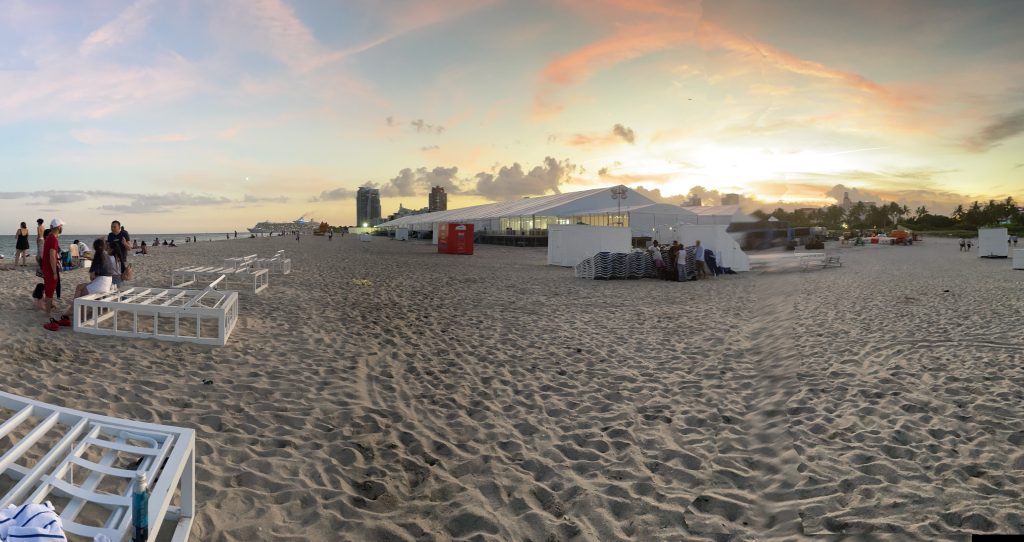
But what is the Miami experience like for neurodiverse families? Read on for our perspective and the POV of several local Miami experts.
A little bit about the “Magic City”
The Miami metro area, which includes Miami-Dade, Broward, and Palm Beach is situated on northern Biscayne Bay between the Everglades and the Atlantic Ocean.
Miami is the largest city in southeastern Florida and the state’s second-largest city (after Jacksonville). Nearly 5.5 million people live in Miami and surrounding areas, making it the largest metropolitan area in the Southeastern U.S.
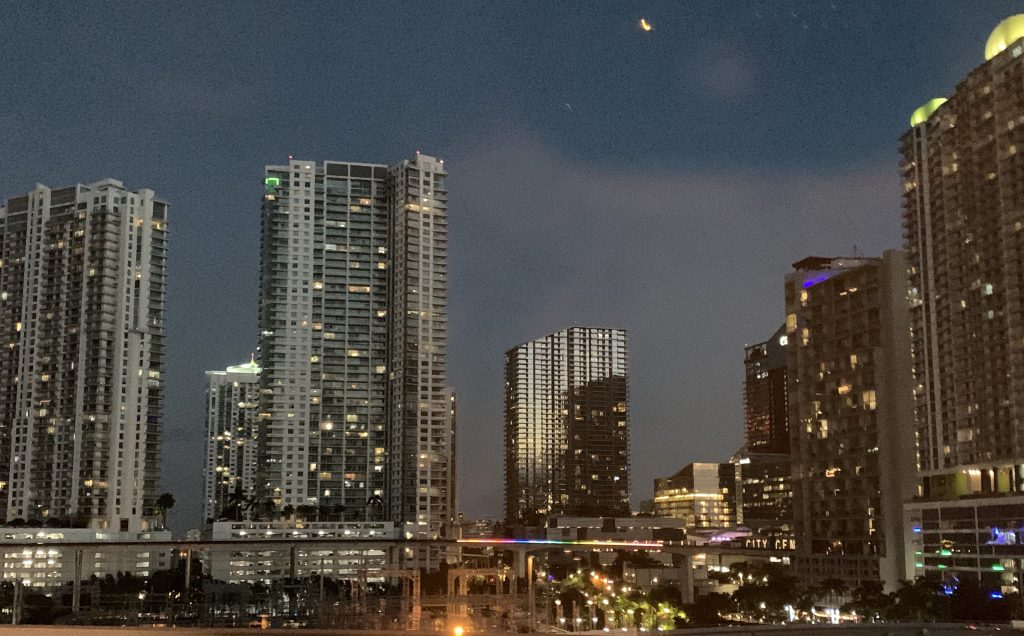
It’s known as the ‘Magic City’ because of its rapid growth spurt – in the late 1800s, it started as a village and, almost overnight, bypassed town status to become a major city.
Miami is also one of the nation’s more densely populated areas, and one of its most diverse, with more than 67% of the people in and around Miami being Latino, including Cuban, Nicaraguan, Haitian, and Honduran. The city has three official languages – English, Spanish, and Haitian Creole.
Interestingly, Miami is the only major U.S. city founded by a woman – Julia Tuttle, a local businesswoman who recruited a railway tycoon to extend the railroad into the Miami area.
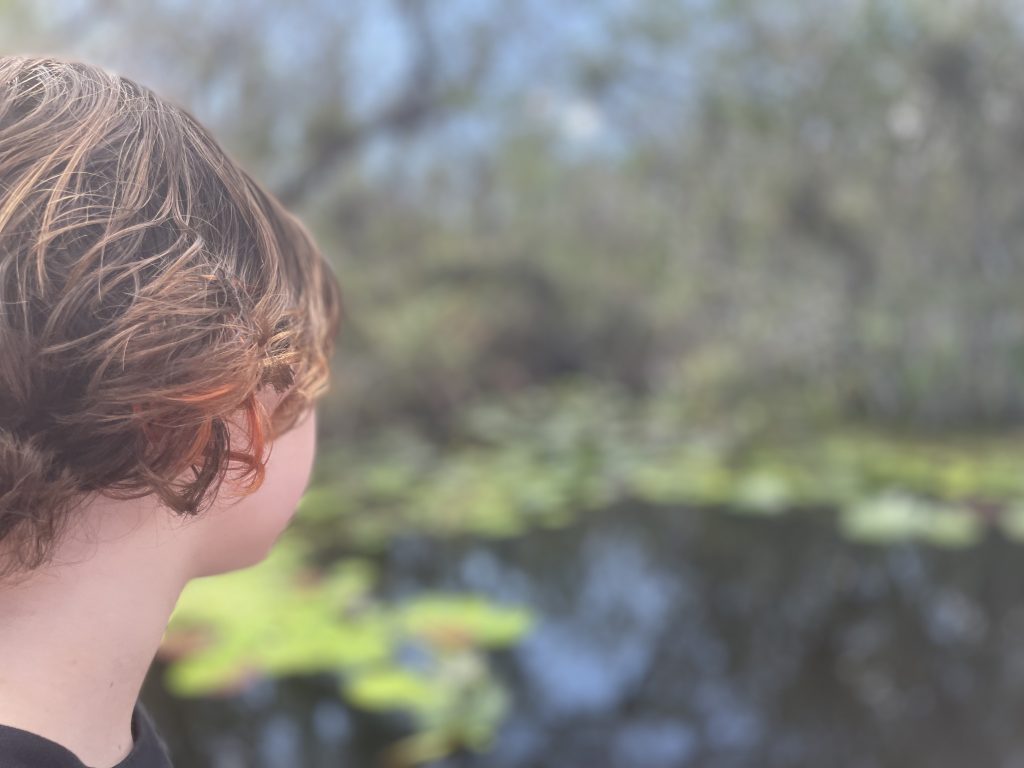
In our view, one of the best things about Miami is the weather…it has mild winters and warm (often hot), humid summers. Average high temperatures are in the mid-70s in the winter, low 80s in the spring and fall, and mid to high 80s in the summer.
Neurodiversity in Miami
There appears to be growing recognition in Miami of both the significant value of neurodiverse individuals for the city’s economic progress, and the importance of providing increased workplace opportunities for people who are neurodiverse.
For example, local consultants have offered training on the benefits of neurodiversity in the workplace, and how to make organizations more inclusive of neurodiverse individuals. Additionally, in late 2022, Miami Dade College Padron Campus hosted a panel discussion that focused on supporting and increasing workforce skills to expand employability for neurodiverse individuals in the Miami area.
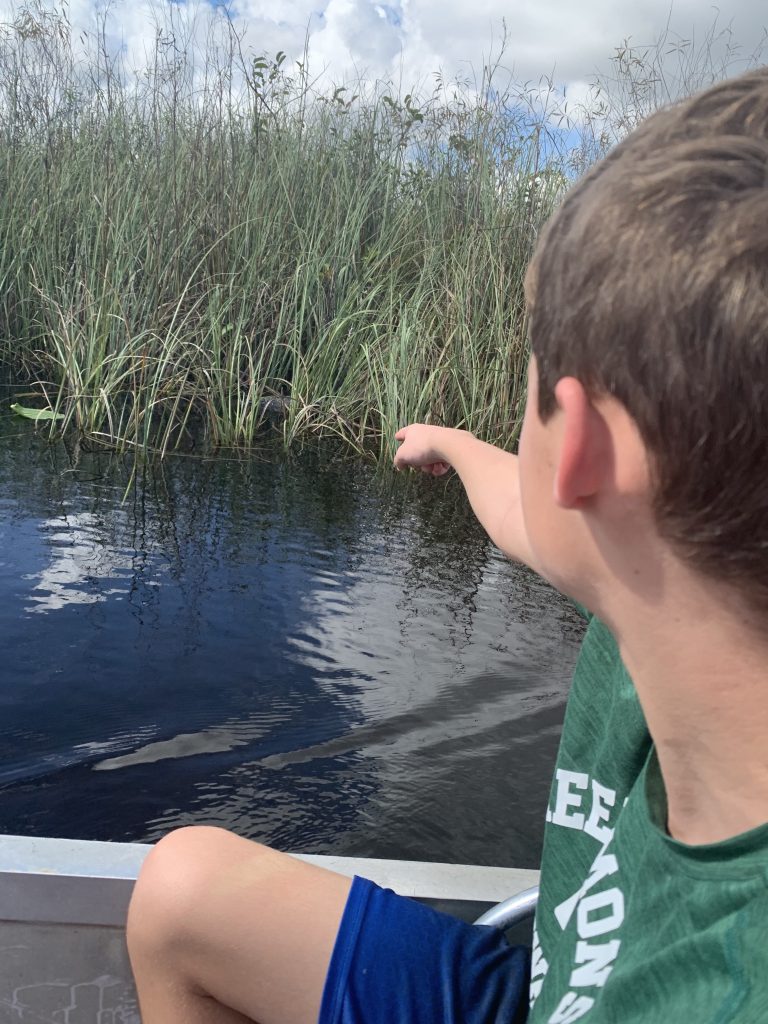
The Dan Marino Foundation, created by former Miami Dolphins football star Dan Marino and his wife Claire in 1992 when their son Michael was diagnosed with autism, provides educational, workplace skills training, and other opportunities for neurodiverse individuals in the Miami metropolitan area. The foundation’s Marino Campus is an accredited postsecondary school that “prepares young adults with autism and other disabilities for gainful employment, social competence, and independent living by earning national industry certifications and gaining necessary skills vital to employment.”
Finally, last year, the Board of County Commissioners for Miami-Dade County passed a resolution directing local leaders to “develop a plan to increase employment opportunities for individuals with disabilities, including neurodivergent individuals, with Miami-Dade county and with vendors who do business with Miami-Dade County.” The resolution also requires the county to develop a report on activities resulting from the resolution.
5 Tips for neurodiverse families adventuring in Miami
- Anticipate heat and sun – drink/bring water, apply sunscreen, bring hats, and look for shade.
- Expect windshield time – there are an endless number of fun things to do in Miami, but activities can be spread apart, so it’s likely you will need to drive distances to get places.
- Get outside – Many of Miami’s gems – beaches, parks, outdoor art, walking/biking, and tours on the water – can be found outside. But also remember to bring noise-canceling headphones in case you run into crowds or loud music.
- Enjoy the multiculturalism of the city – it’s every you look, listen, and eat. Embracing it can help your neurodiverse family appreciate it.
- Prepare your neurodiverse family beforehand, and give family members choice in your adventure through perusing online sites – there are a million of them; here are just a few good ones: VisitTheUSA.com, Greater Miami & Miami Beach, and Miami Mom Collective.
ROCKETAROUND.COM’S MIAMI EXPERIENCE
For our family, Miami offered so much for our family to do (but a lot of windshield time), and a uniquely diverse experience within the U.S. highlights from our Miami adventure included…
Beautiful Beaches – Miami is a beach mecca. How many beaches does Miami have? That is a question to which I cannot find an answer. But with more than 20 miles of Atlantic coastline, no matter where you drive, you’re never far from a beach.
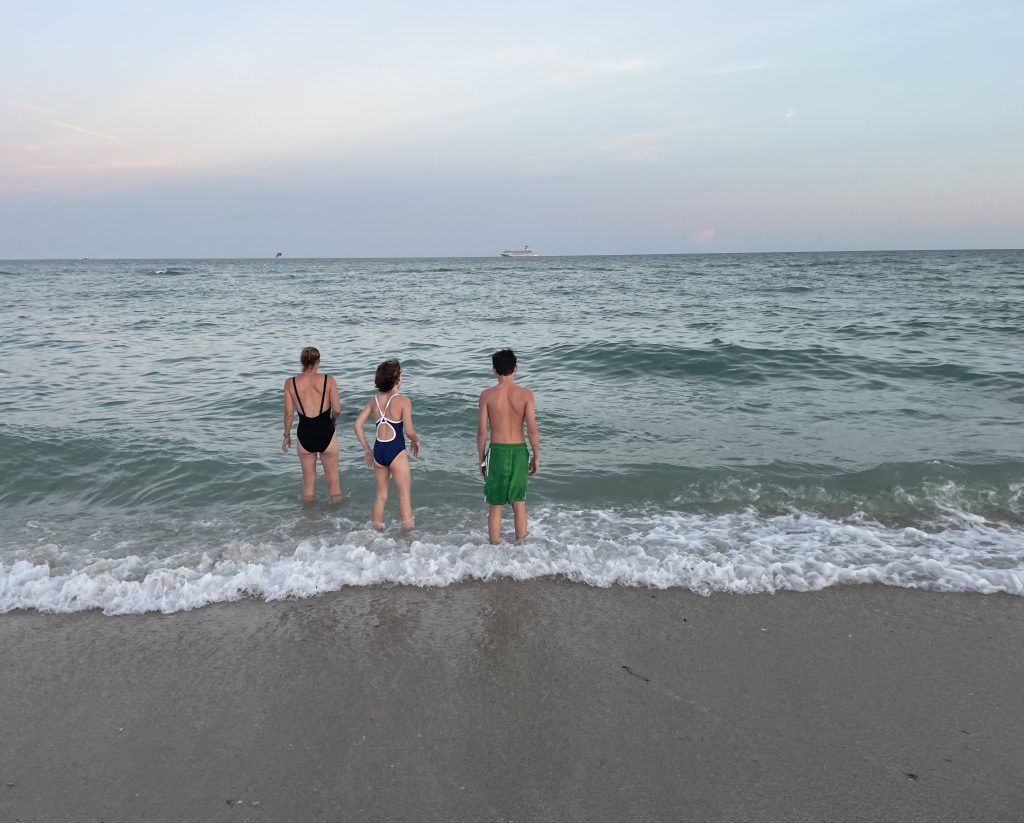
From Frommer’s to Time Out and Florida’s tourism sites – there is no shortage of guides and articles that offer perspectives on the best beaches in Miami for whatever your interest – from swimming to surfing, sunbathing, working out, hiking, or picnicking. We researched the best beaches for families and ultimately went to these three during our trip, in order of which we enjoyed most:
Hollywood Beach – We wound up here primarily because it was close to Miramar, where we stayed on our visit, and were pleasantly surprised by its beauty and quiet spots along the sand. Hollywood Beach sits between downtown Miami and Ft. Lauderdale and has landed on Travel + Leisure magazine’s America’s Best Beach Boardwalks list in recent years. In addition to a boardwalk, it offers a gorgeous 2.5-mile stretch of beach, solid waves for body surfing, beachfront restaurants, and bars, plus a brick-paved thoroughfare that draws many walkers, joggers, bicyclists, and rollerbladers.
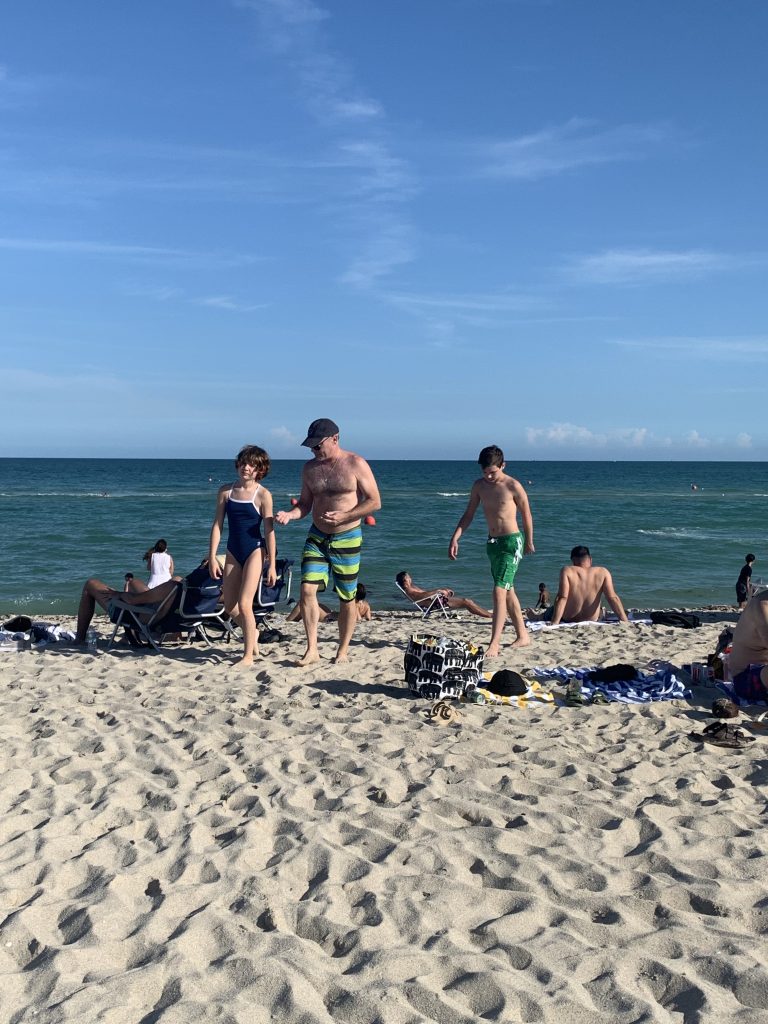
Miami Beach – In transparency, lists of top Miami beaches for families included Lummus Beach, which we intended to go to and plugged into our online GPS app, and the app told us we had arrived at Lummus Beach when it was actually Miami Beach. Lummus Beach may be terrific for families…but we couldn’t find it! About Miami Beach – it’s actually more than a beach – it’s a man-made island city and beaches off the south coast of mainland Miami. So, in addition to wide stretches of beaches and parks, it has restaurants, bars, shops, and lots and lots of people.
The number of island residents – just over 80,000 – is dwarfed by the number of visitors each year – about 23 million. It was all the things you might read about it – colorful, vibrant, exciting – and for a neurodiverse family, it was a little much. Parking was not the easiest to find, we went on a day when the World Cup was underway and it was wall-to-wall people in the restaurants and on the streets, the beach was also crowded and hot in the middle of winter, about 30 percent of the beach where we were was under construction for an upcoming international art show (Art Basel), and the water had a lot of ocean debris floating in it. Most of the family was fine – for one of our kids, it was overload, and so we parked him on a lounge chair with an umbrella with snacks and digging equipment and we all did our own thing within view of one another.
Highlights from this beach trip included seeing how different it was from the other beaches we visited, a delicious Cuban meal we ate toward the end of the day, and the Art Deco District (see below).

Key Biscayne – We visited this gorgeous stretch of ocean-surrounded land to see another family we knew who was also visiting the Miami area and staying in Key Biscayne. Overall, it was stunning – accessed in about 25 minutes from downtown Miami by crossing a miles-long panoramic bridge called the Rickenbacker Causeway, it felt like we teleported to a far-away tropical destination. Key Biscayne invites you in and then surrounds you with beachy feeling shops, golf-cart riding locals, beautiful houses, all-glass condo building palm trees, parks, pools, sand, and, yes, beaches.
We loved our visit here – we had access to an incredible property with multiple pools, beach volleyball, a restaurant, and a beach, and were able to ride a golf cart around the Key to see views you can’t get to by car – so the trip to Key Biscayne was a highlight of our trip, but the beach itself was not really swimmable the day we were there. Local authorities had put a health warning in place because sewage had leaked into the ocean waters in Biscayne Bay, and it MAY NOT be safe to swim. One of our kids went in before the warning was communicated to the parents, and they didn’t have any skin slough off or turn fluorescent green, but we didn’t go into the ocean the rest of the day. Apparently, this is an increasing issue in Biscayne Bay around this key, a sad effect of so much growth in what is otherwise paradise.
Other beaches: The issue with sewage in the waters off Key Biscayne is also unfortunate because several of the beaches that regularly appear on lists of top ones for families – including Crandon Park Beach and Bill Baggs Cape Florida State Park. Other beaches that rank high for families according to online sources include Matheson Hammock Park, South Pointe Park (in South Beach), and Haulover Park, although a stretch of Haulover Beach is an officially sanctioned nude beach, so visitors would want to have more details before visiting.
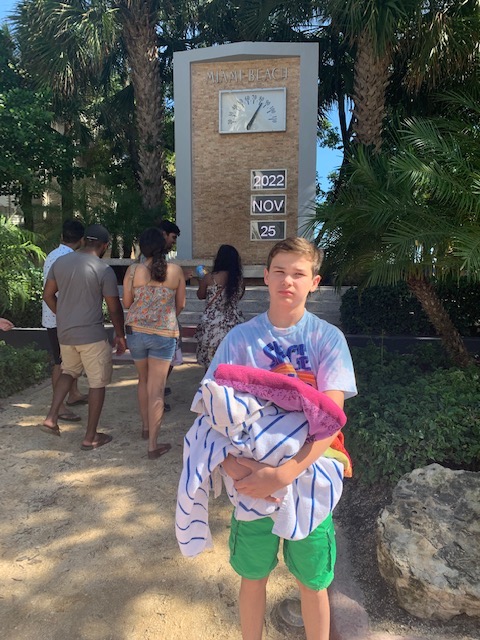
The Art Deco District: Miami Beach is home to the world’s largest display of art deco architecture. The more than 30 blocks of restaurants, shops, and hotels featuring Art Deco facades and fountains can be found throughout the island city, but especially in the historic district. These brightly painted structures – some of which date back to the 1920s and 30s and totaling about 800 – double as pieces of art. If you walk, bike, or drive along 5th Street and 23rd Street in Miami Beach, between Ocean Drive, Collins Avenue, and Washington Avenue, you can’t miss it.
Coral Gables: Our visit to Coral Gables was one of the best days of our trip. The Miami-metro city is located 7 miles – or 11 km – southwest of Downtown Miami and has a population of about 50,000. It’s best known for being the home of the University of Miami – a research university with a main campus spanning 240 acres.
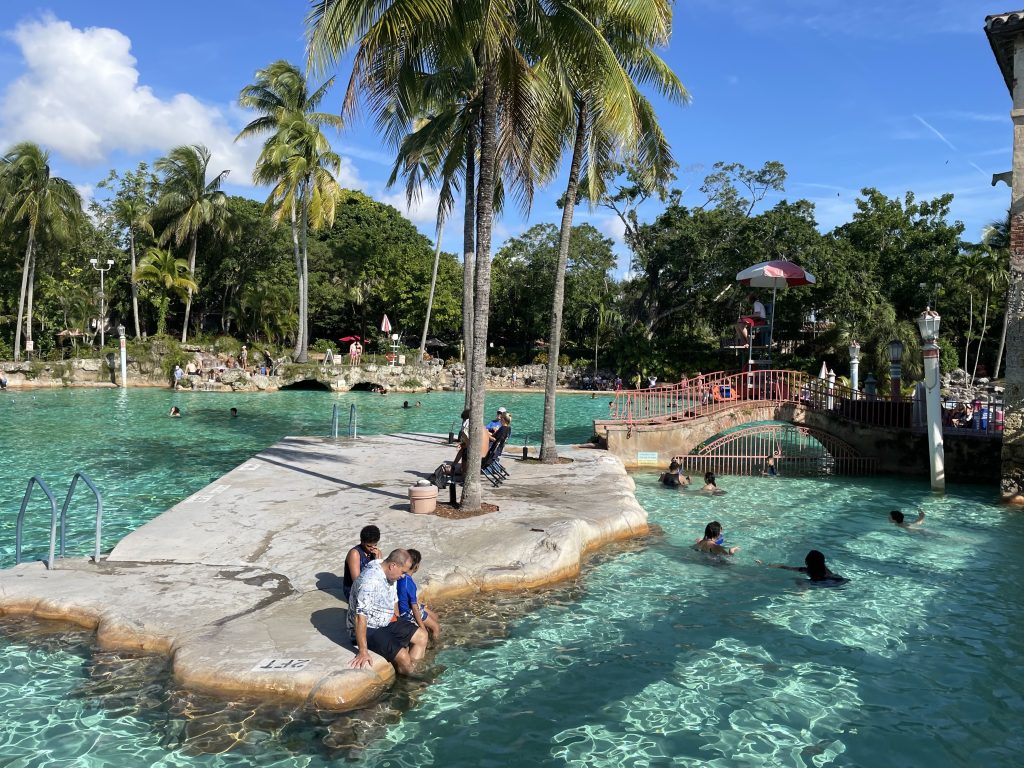
But we spent our time in the area surrounding the university, where you’ll find a Mediterranean-themed planned community, on Miracle Mile – in the Central Business District between LeJeune Road and Douglas Road, which offers excellent and varied restaurants (more on that below), shopping and entertainment, and at the Venetian Pool – which some sources say is the most beautiful public pool in the world.
The pool, which opened in 1923 and used to be a stop for movie stars and beauty queens visiting the Miami area, is replenished daily with spring water from an underground aquifer. With multiple waterfalls, cave-like grottos, rocks for climbing or sun-bathing, a roped-off portion of the ginormous pool for young children, and Venetian- style (of course) locker rooms and grill, it’s definitely worth a visit. One note – it is a little pricey for a family: $16 – $21 (depending on the time of year) for 13 and over and $11 – $16 for children 3 to 12 years, plus refundable money to use onsite lockers.
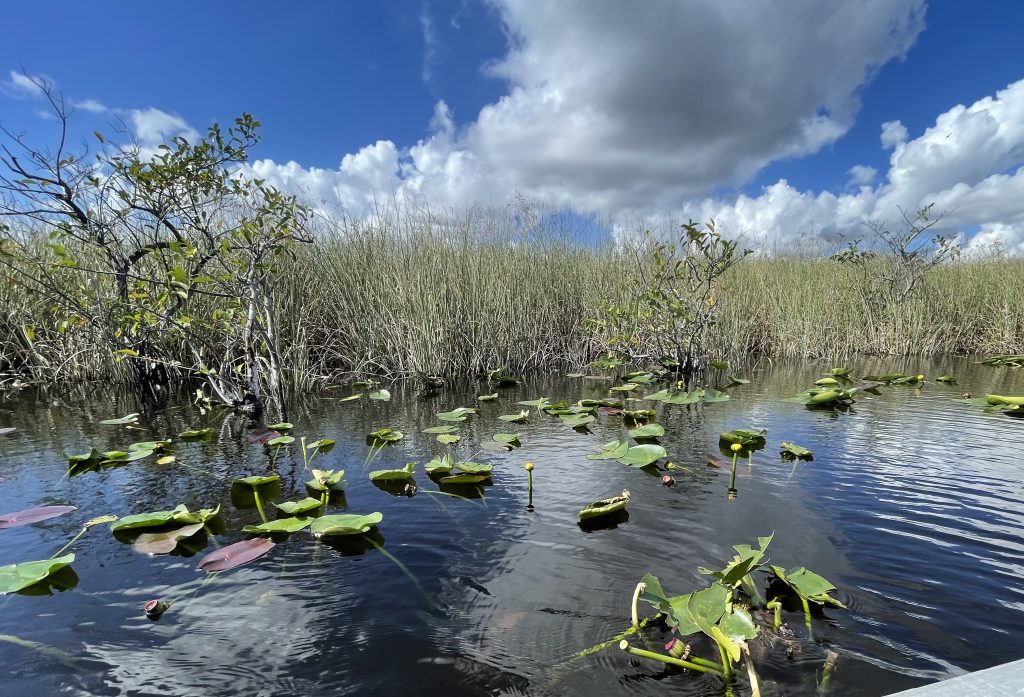
The Everglades: Another highlight of our trip (come to think of it, there were a lot of highlights!). Everglades National Park is apparently “the largest subtropical wilderness” in the U.S. and is protected by numerous U.S. and international bodies because it provides a habitat for 36 threatened or protected species, from crocodiles to manages and even panthers and more than 700 species of birds, fish, mammals, and reptiles. The Everglades is a vast 1.5-million-acre network of forests and wetlands nourished by a massive river– so it’s advised to have a plan before you venture into it.
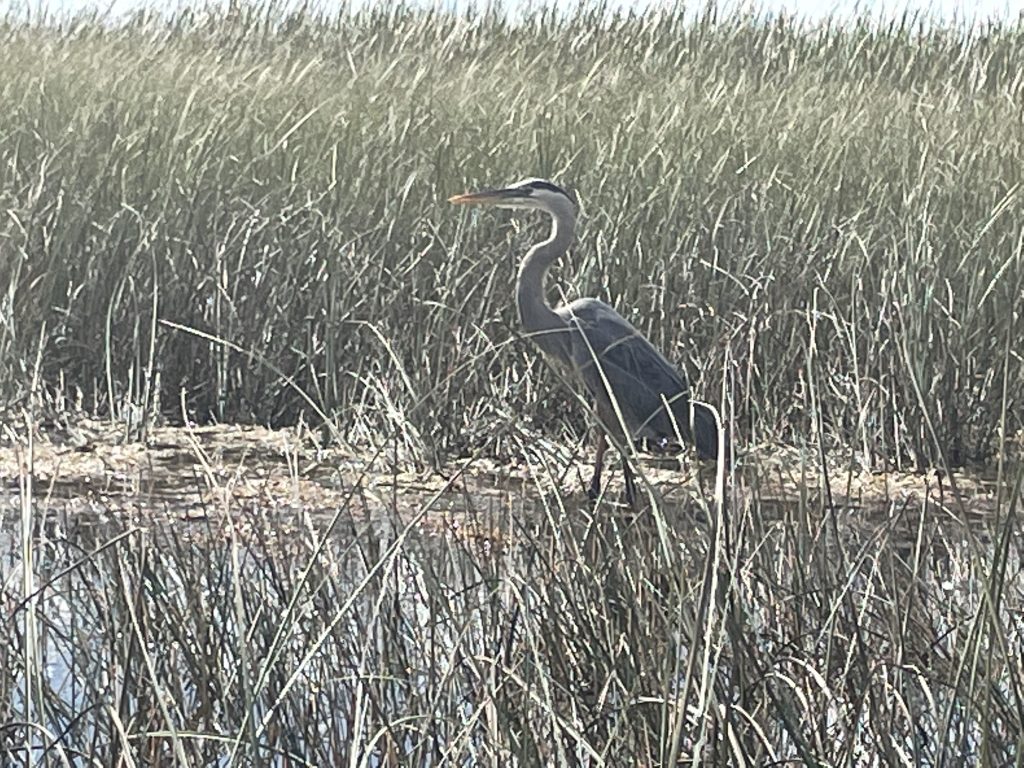
When driving in the Everglades, you can tell you’re upon it when the land is flat every which way you look, and marsh grass stretches out around you. As we ventured in, the road was nearly equal with the marsh in some areas, which I would imagine means flooding could be a frequent occurrence. There are many different types of tours you can take to see the Everglades – from motorboats to airboats, canoeing, kayaking, walking, helicopter, or combination tours, one to multiple hours, morning, noon, or night – and there are a significant number of places from which tours depart.
Each kind of tour offers its own advantages. We opted for an hour-long airboat tour from Gator Park that included a wildlife show – it did not disappoint. We saw much wildlife along the way – including two alligators – had a very knowledgeable guide and tasty lunch of alligator bites, and the way the wildlife show guide handled alligators and crocodiles was astounding – I would be shocked that he’s still alive, but he really seemed to know what he was doing.
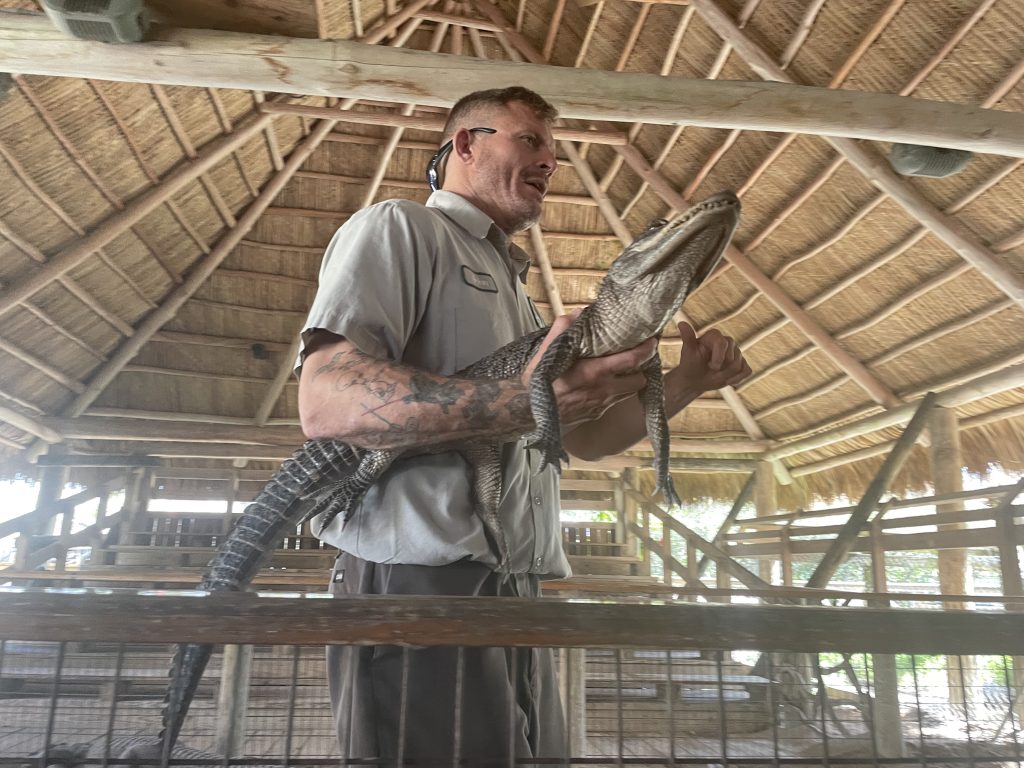
One note – airboats are propelled by giant fans that push air behind the boat, which in turn moves the boat forward. The fans can be loud, especially when the boat gets to a higher speed (e.g., 30 – 40 mph) and I’ve read the noise can be difficult to take for individuals with sensitive hearing. Our neurodiverse family was okay with earplugs provided to us by the airboat operator, but the operator also offered earphones that seemed to mollify people for whom the earplugs weren’t enough.
Prices for tours vary widely – from under $20 per person to more than $150 per person. The price point for our tour as about $35 per person and it was well worth the money.
Food – Miami offered a terrific mix of different types of restaurants that served the more and less adventurous among us well. And there were so many restaurants, especially in the more touristy areas, that we were able to satisfy everyone almost all the time. While there, we had delicious Cuban food in Miami Beach, excellent ramen in Coral Gables, fresh seafood and salads in Key Biscayne, and tasty alligator bites (a lot like small chicken nuggets) in the Everglades.
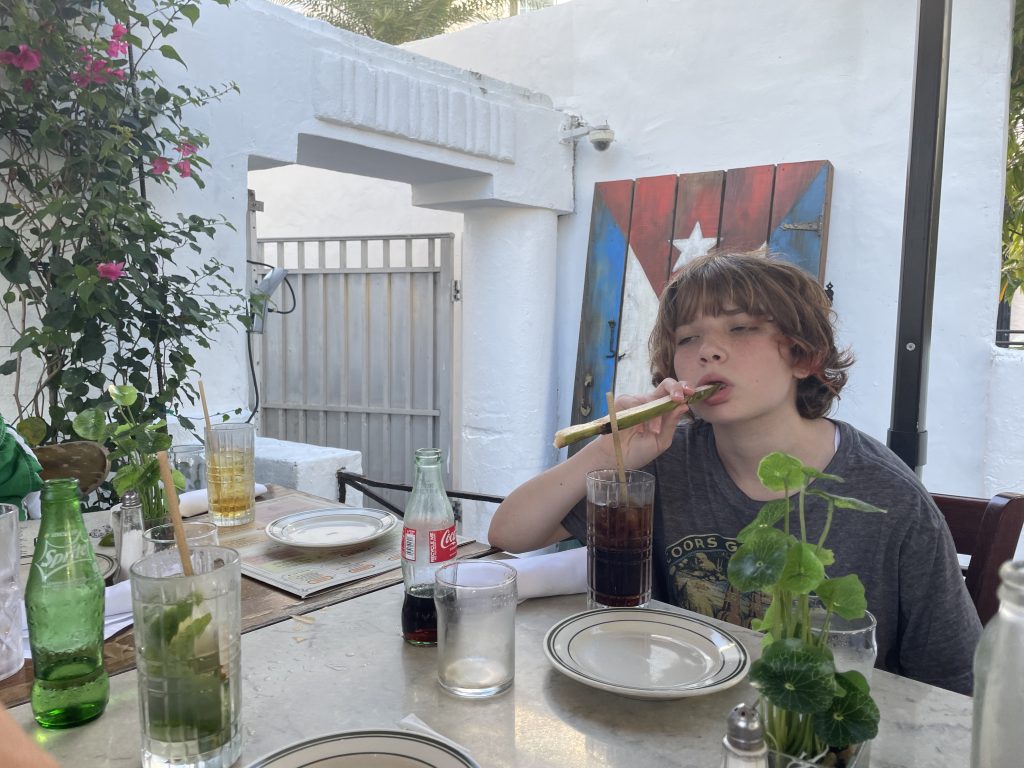
Because we stayed for most of the trip in a rental house, we also made numerous trips to a nearby grocery store, and always had snacks with us case we needed them.
Admittedly, our kids often defaulted to chicken tenders, but they did branch out and try new things in Miami, including the various Cuban dishes, alligator, and other seafood and ramen.
A few notes about food in Miami, the city is known for its Cuban food – and Cuban restaurants can be found all over the metro area (there’s even a Cuban restaurant tour in the Little Havana neighborhood of Miami), but because Miami is a melting pot of people from across Latin America and the Caribbean, you can have your pick of food from across these regions – Mexican, Columbian, Peruvian, Dominican Venezuelan, Nicaraguan – you name it, it’s there.
And food options are definitely not confined to just one or two areas – various Miami neighborhoods are known for their restaurant availability and selection. From beachside and corner café to high-end, Miami is a food city.
Other activities – There are two other activities we enjoyed during our trip to Miami: walking and local music.
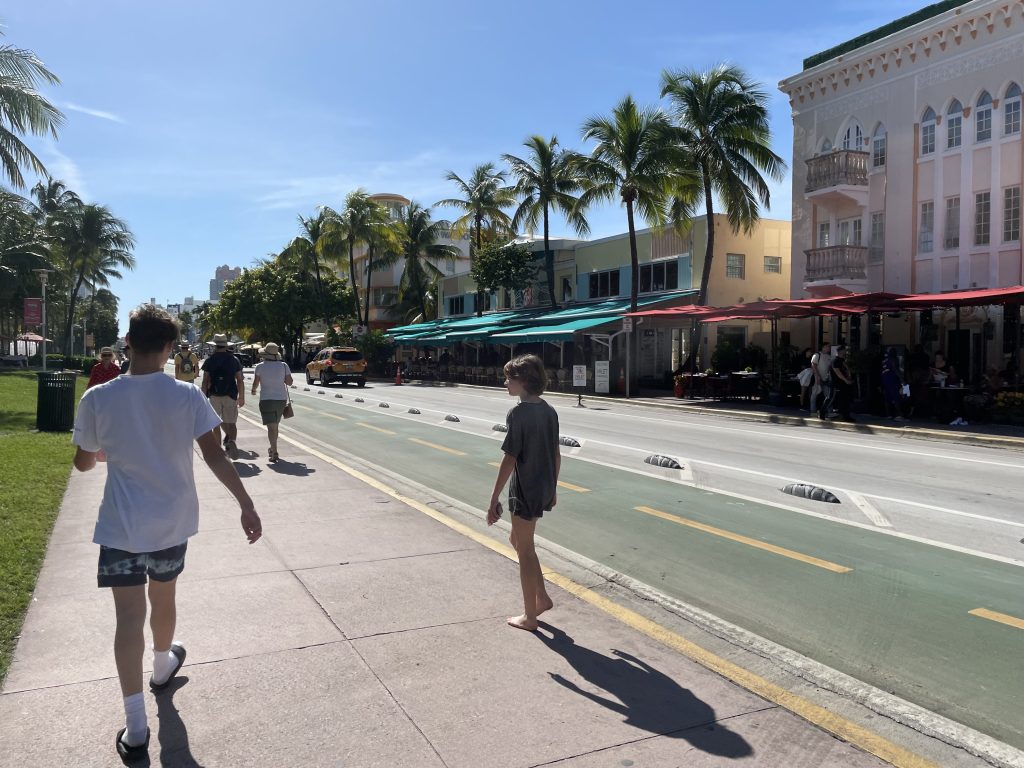
Because the city has warm weather throughout the year even in the winter months Miami is an ideal destination for walking and biking. Parts of the Miami metro area are extremely busy, and you might not necessarily want to venture out on foot or on bike in those areas. But because Miami has many park areas, and walking and biking trails, you can find somewhere to exercise very likely close to where you are staying. We walked every day we were there – either through the neighborhood in which we stayed, or in the various neighborhoods we visited.
Because of its diversity, Miami also has a vibrant music scene. It is home to thousands of musicians and music festivals (according to one source, “4,000 artists and musicians, 136 music festivals” to be exact), and when we visited, because certain parts of the city (e.g., Miami and South Beach) have a party-feel to them any time of the day or night, we could hear live Latino music wafting out of restaurants as we wandered through certain neighborhoods.
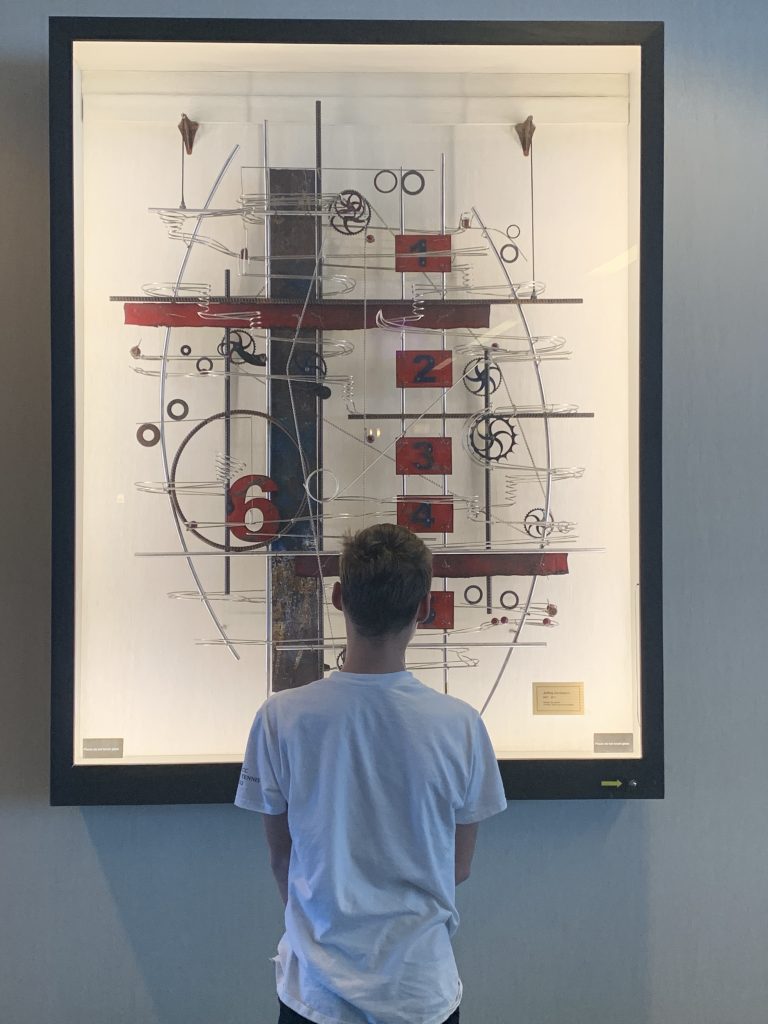
Hotel and Air B&B’s: During our stay in Miami, we had the chance to spend a night in a downtown hotel and the rest of the time in an Air B&B, so that we could compare these experiences for our neurodiverse family.
Hotels – as in any touristy city, Miami has a seemingly endless choice of hotels, from luxury to budget and everything in between. There are no autism-certified hotels in the Miami area (some call themselves autism-friendly, but nothing certified), so the best you can do is look for something that has amenities that work for your neurodiverse family. For part of our trip, we stayed at a Hampton Inn in Brickell-Downtown and it was okay on the amount of space and beds for the price, breakfast buffet on-site, and amenities that worked for our family (e.g., a pool and walkable restaurants), but being right in the middle of a crowded city with all-night lights was overload for our neurodiverse family members.
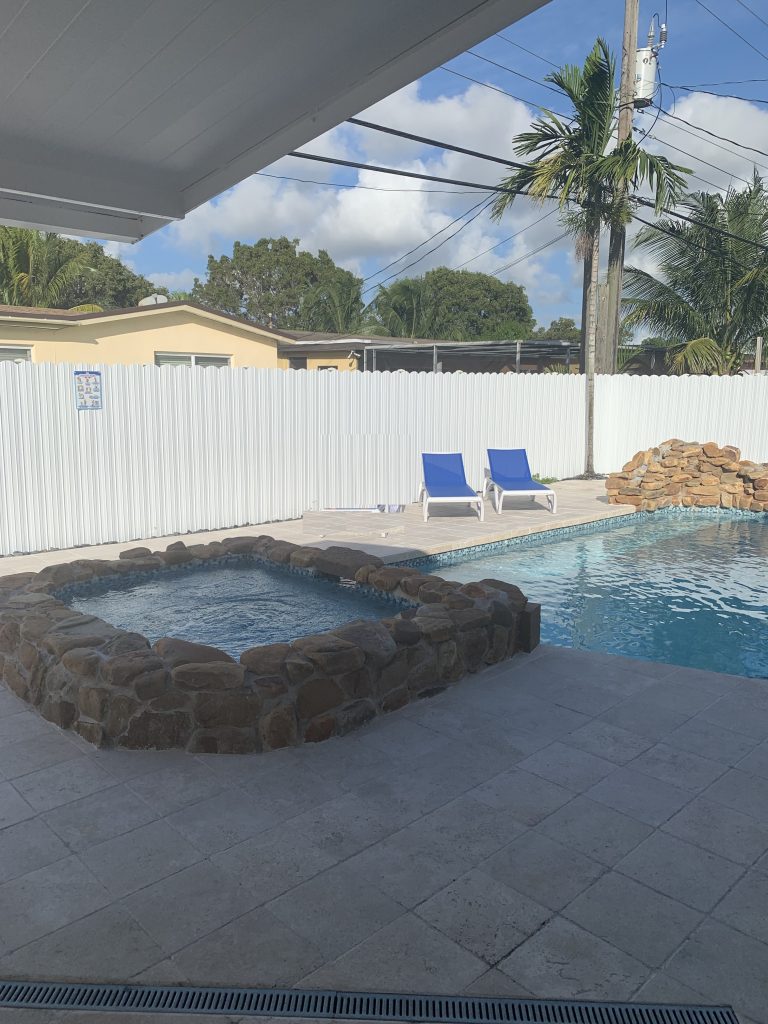
Rental properties: The house we rented for the remainder of our trip was in a less desirable location (Miramar) but had lots of room to spread out – including beds for everyone and lazy-boy couches for downtime – and a set of amenities that worked well for our family, including a pool, hot tub, pool table, darts and great outdoor dining area and swing. The rental was also, as you might expect, more cost-effective per night and allowed us to make meals that worked for our kids. There are tons of rental houses throughout the metro Miami area; the trick is to figure out whether the location of a house is in an area that works for your family and plans.
GREAT LOCAL PERSPECTIVES
Our perspective only goes so far…so we talked with a number of moms with the Miami Mom Collective to share their insights into what neurodiverse families should consider experiencing in Miami and what can make a family’s experience the best possible.
The Miami Mom Collective is an amazing resource for moms local to or visiting Miami and cared for by more than 50 Miami moms and influencers. Their guides, blogs, and calendars are truly invaluable to a neurodiverse family who hopes to conquer, or just make a dent, in Miami. Collective team members Krystal J. Giraldo (@theinclusivemama on Instagram), and Jacqui Jebian Garcia (speech-language pathologist and social-emotional coach (@createyourselfco on Instagram and Www.createyourselfco.com) shared their amazing insights with us and we share them here with you…
Must-see in Miami
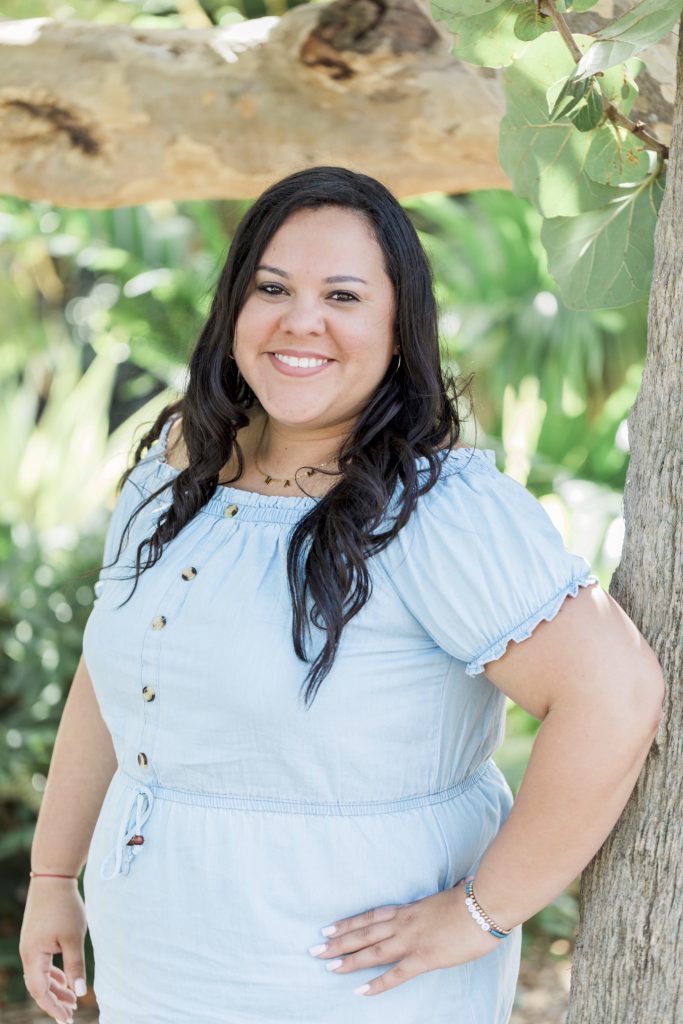
What Krystal Giraldo loves to do with her family in Miami…Anything outside is fun for my son, but being outside for too long can get hot here in Miami! We prefer shaded playgrounds without sand. My son is also a huge fan of water, pools, and splash pads. We recently found a church in South Miami that has an inclusive kids’ church, and he absolutely loves it. I’m also on an email subscription list for Evite and have my settings saved for Family and Miami. I’m big on community events and farmers’ markets. My teenage stepdaughter (neurotypical) also finds most of these things to do fun.
Miami-area activities for a neurodiverse family with younger children (under 10 years old) – Krystal recommends…
The Zoo: We walk the zoo during cooler months and only go to the slash pads during the warmer days. There is very little shade, the monorail has closed, and the Zoo is miles long.
Miami Seaquarium (Warning: if you’re an animal activist and triggered by animal conditions- this may not be the place for you. I found it to be sad and hard for me to post on social media. But my son LOVED it and was very engaged with everything there)
Miami Children’s Museum (try early mornings or weekdays- weekends were too much for us, very crowded) They have a sensory room which my son loves but only when it’s respected for the way it was intended. Staff is not there to regulate other families.
Sensory Friendly Sundays at Chuck E Cheese: they have removed the ball pits and play area and have specific Sundays dedicated to the Special Needs Community.
Miami-area activities for a neurodiverse family with older children (over 10 years old) – Krystal recommends…
- Outdoor restaurants: Great for people-watching.
- Outdoor Malls like the Falls or Sawgrass
- The movies: They also have Sensory specific days, but we have not ventured to the movies, but this can be found online.
- Adrienne Arsh Center and other theaters around Miami: Also have Sensory Specific times and they feature wonderful shows.
Jacqui Jebian Garcia recommends…

Anything outdoors – sounds don’t sound as loud outdoors and being around nature is grounding for everyone of all ages, including adults.
Berry Farms was a great experience – lots of opportunities for jumping, obstacles, an oversized sensory bin of corn kernels, and Playhouses made of wood that were not just aesthetically pleasing, but also great for our kids’ imagination.
Zoo Miami and Miami Seaquarium are two places that my 6-year-old son is always requesting.
Frost Museum (indoors) – One of our favorites – lots of multisensory stimulation there from room to room, from visual stimulation on their interactive dance floor to visual stimulation on their interactive walls with animals, water tables, and real-life aquariums. Krystal says also see the planetarium.
Legoland in Orlando will become autism certified in that each ride will break down the stimulation in provides by each sensory system.
What can help your neurodiverse family Rocket around…
Jacqui says…
When traveling locally or from afar, bring along anything and everything that your child needs to stay calm and regulated throughout the day, especially in new environments. We cannot control the sensory input we receive in this sensory world; however, we CAN create modifications to meet our child’s sensory profile. Bring:
- Those noise-cancelling or noise-reducing headphones to modify the amount or intensity of auditory input if your child is sensitive to sounds.
- A blanket to sit on if your child is sensitive to grass.
- A soothing item to help them self-sloth/feel calm.
- A stroller if your child becomes tired quickly when walking.
- A fidget toy if your child needs to move their body in a setting where they need to stay seated. Something heavy or weighted to give them that deep pressure input they are seeking.
- Your white noise machine and a light projector if it means they will sleep better.
- Their electric toothbrush if they need an alerting way to start their day.
- A portable swing if it means they will be calmer given that vestibular input throughout the day (or make it a point to visit one of our beautiful local parks to give them that stimulation their body needs – check out Miami Mom Collective’s local parks guide!).
- Their favorite snacks to stimulate them accordingly (so crunchy snacks would be alerting vs thick smoothies would be calming).
- Visual schedules/timers – if that is something you implement at home, bring it with you on vacation. Knowing what comes next in their day helps promote positive behavior.
- The most important thing is to follow your child’s lead while being proactive (meaning not waiting till the point of dysregulation to implement a sensory strategy), and to teach them to advocate for their body’s needs as they know their body best!
Krystal says…
- Wear your sunscreen.
- Drink water (everyone should have their own)
- Don’t take the rudeness of our drivers personally.
- Prepare and time your outings with expectations of traffic and construction.
- Miami Beach is not Miami – traveling to and from Miami Beach should be graced with an hour (or more) of travel time.
Also, check out Krystal’s Miami Mom Collective website article 5 Tips for Visiting Family With a Child With Special Needs
Happy travels to the Magic City!
OTHER MIAMI RESOURCES
- Miami Mom Collective 305: A Mom’s Guide to All Things Miami
- Articles by Miami Mom Collective contributor Jacqui Jebian Garcia, including articles on sensory processing and neurodiversity in motherhood
- 10 Best Family-Friendly Beaches and Pools in Miami | The Storage Space
- 14 Best Beaches in Miami For Families (2023)! – ALWAYS ON THE SHORE
- Miami Is The Second Best City For Art And Music Lovers In The U.S., Study Finds – Secret Miami
- The 5 best beaches in Miami for families – Globetotting
- The 50 best Latin and South American foods and restaurants in Miami
- The Eater’s Guide to Miami’s Best Food and Drink – Eater Miami
- Things You Should Never Do in Miami, According to a Local
Have a good Miami resource? Let us know and we’ll add it here.


1 Comment
Pingback: Check out Rocketaround.com’s new Neurodiverse Family Guide to Miami! – Rocket Around